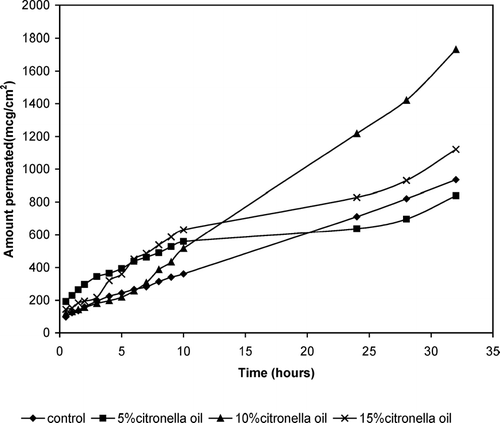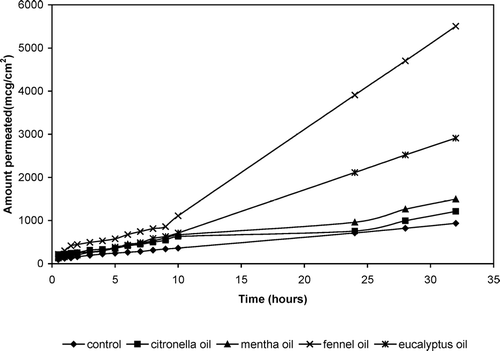Abstract
The aim of our study was to investigate the enhancing effect of several essential oils in the percutaneous absorption of trazodone hydrochloride (TZN). For this purpose, fennel oil, eucalyptus oil, citronella oil, and mentha oil were applied on the skin membrane in three different ways: included in the transdermal device, as a pretreatment, or both. To investigate the effect of penetration enhancers used in this study on the percutaneous absorption of TZN through mouse epidermis, Keshary-Chien diffusion cells were employed. The receptor phase was constantly stirring saline phosphate buffer of pH 7.4 at 37 ± 1°C. Results showed that pretreatment of skin with essential oils increases the flux values of TZN compared with the values obtained when the same essential oils were included in the transdermal devices. The percutaneous penetration flux for TZN was increased with skin pretreatment by 10% essential oils in the following order: fennel oil > eucalyptus oil > citronella oil > mentha oil. The amount of TZN retained in the skin after pretreatment with essential oils was found to be very similar in all cases and much higher than in the experiments without skin pretreatment.
The undesirable side effects of trazodone hydrochloride (TZN) administered orally can be offset by using the transdermal route, which attenuates the fluctuating TZN levels resulting from oral therapy. TZN is a good candidate for transdermal drug delivery (Gorecki and Verbeck Citation1987; Goodman and Gilman Citation1990); however, relatively large doses are required to attain effective plasma concentrations for treatment of moderate to severe depression in schizophrenic patients. Permeation enhancers may possibly increase the percutaneous absorption of TZN so that a therapeutically effective dose can be delivered transdermally. Permeation enhancers can increase the permeability of the stratum corneum by increasing drug diffusivity within the membrane and/or by increasing drug partitioning from the applied formulations into the skin (Barry Citation1991). The effect of these compounds on the percutaneous absorption profile of drugs has been quantified by permeation parameters, such as the drug flux across the skin and the drug skin retention (Baker and Hadgraft Citation1995).
The present study evaluates the enhancing effect of several essential oils, delivered in different ways, on the in vitro percutaneous absorption of TZN across mouse epidermis. Essential oils in propylene glycol were applied as a pretreatment, added in the systems, or both. The skin retention of TZN after pretreatment with essential oils and application of transdermal films containing essential oils also were measured.
The essential oils are currently receiving much attention as penetration enhancers due to their low toxicities compared with the synthetic penetration enhancers. Some essential oils and their terpene constituents have been investigated as potential penetration enhancers (Cornwell and Barry Citation1995; Moghimi, Williams, and Barry Citation1996a, Citation1996b, Citation1996c; Monti and Saettone Citation1997; Gao and Singh Citation1998; El-Kattan, Asbill, and Michniak Citation2000; Jain, Thomas, and Panchagnula Citation2002; Monti et al. Citation2002; Narishetty and Panchagnula Citation2004). In our study the essential oils selected were eucalyptus oil, citronella oil, mentha oil, and fennel oil. Eucalyptus oil has been used as a topical counterirritant and decongestant. Its chief constituent is 1,8 – cineol (∼80%). Mentha oil contain menthol (∼44%) and menthone (∼25%). Fennel oil has been used as an aromatic and carminative. Its principal constituents are the phenolic ether transanethole (∼60%) and the ketone fenchone (10–30%). Citronella oil is used in perfumery and has antimicrobial activity. Its chief constituent is citronellal, an aldehyde.
MATERIALS AND METHODS
Trazodone hydrochloride (ICN Biomedical); di-sodium hydrogenorthophosphate (Qualigens Fine Chemicals, Mumbai); potasium di-hydrogen orthophosphate (BDH Chemical); sodium chloride, acetone, and Isopropanol (Ranbaxy Laboratories, New Delhi); triethylcitrate (Merck, Germany); fennel oil, eucalyptus oil, mentha oil, and citronella oil (Allied Chemical Corporation, Vadodara) were used.
Preparation of Backing Membrane
Eudragit NE 30D suspension was dried in air. The films thus obtained were crushed into pieces. Then 250 mg of the polymer was dissolved in 5 ml of acetone and poured over an aluminum dish and dried overnight. Judging the degree of transparency monitored dryness of the casted films.
Preparation of TZN Transdermal Films
The polymeric solution (10% w/v) was prepared by dissolving Eudragit RL100 and Eudragit RS100 (1: 3 ratios), along with 13% w/v of plasticizer triethylcitrate in a mixture of isopropanol and acetone (3:2). TZN (10%w/w) was dispersed in the polymeric solution being kept under magnetic stirrer for uniform dispersion (control film). The enhancers at different concentration were added to the mixture after dissolving the polymers. The mixture was poured into aluminum Petri dish (13 cm2) containing backing membrane and dried under control conditions to reach a stable drug-polymer matrix.
In Vitro Permeation Studies
Male albino mice were sacrificed by excess chloroform inhalation and abdominal hair was shaved using an electric razor. The abdominal skin was surgically removed and adhering subcutaneous fat was carefully cleaned. The full thickness skin thus prepared was soaked in distilled water at 60°C for 30 sec, followed by careful removal of the epidermis with intact stratum corneum (Kaidi and Singh Citation1998). The epidermis was washed with distilled water dried in desciccator at approximately 25% RH, wrapped in aluminum foil, and stored at 4 ± 1°C (Swarbrick and Bom Citation1982). Skins were allowed to rehydrate for 1 hr before being mounted on the Keshary–Chien diffusion cell with an available diffusion area of 2.84 cm2 with the stratum corneum facing the donor compartment. The stratum corneum side of the skin was kept in intimate contact with the release surface of the transdermal films. The receiver phase was 18 ml saline phosphate buffer of pH 7.4 stirred on a magnetic stirrer. The whole assembly was maintained at 37 ± 1°C. The amount of drug permeated was determined spectrophotometrically at 246 nm by removing 1 ml aliquot through a hypodermic syringe fitted with a 0.22 μ membrane filter, at designated time intervals, for a 32-hr period. The volume was replenished with the same volume of prewarmed receiver solution.
Pretreatment of Skin
The solutions for the pretreatment were propylene glycol and different essential oils in propylene glycol at 5% and 10% w/w level. This enhancer concentration was chosen on the basis of results obtained in a previous investigation, also dealing with essential oils (Monti and Saettone Citation1997). The skin was pretreated by placing 1 ml of the pretreatment solution on the stratum corneum side of the skin in the donor compartment for a 12 hr, after which the enhancer solution was removed and the remaining enhancer on the surface of skin was eliminated. The percutaneous penetration experiment was carried out by mounting the transdermal films in the donor compartment.
Determination of TZN in the Skin
At the end of the permeation experiment, the exposed skin was washed using distilled water and blotted dry. The treated skin area was weighed, cut into small pieces, and placed in 5 ml of saline phosphate buffer of pH 7.4 with occasional stirring for 24 hr. The desorbing solution was filtered through membrane filter, and the amount of TZN in the filtrate was then determined spectrophotometrically at 246 nm.
Data Analysis
The in vitro skin permeation rate or flux was calculated directly as the slope of the linear plot between the steady-state values of the amount of drug permeated (μ g/cm2) versus time in hours (Bonina et al. Citation1993). Permeability coefficients were deduced by dividing the flux by the initial drug load (μg/cm2). Penetration enhancing activities are expressed as enhancement ratios (ER), i.e., the ratio of the flux value with enhancer to that obtained without enhancer.
Statistical comparisons were made using Student's t-test. The chosen level of significance was p < 0.05.
RESULTS AND DISCUSSION
Skin Pretreatment with Essential Oils
The TZN permeation data from control film after skin pretreatment with essential oils are summarized in . As essential oils were dissolved in propylene glycol, skin was pretreated with this substance to elucidate if propylene glycol (PG) itself acted as percutaneous enhancer for TZN absorption. TZN permeation through mouse epidermis was significantly enhanced (p < 0.05) by PG pretreatment. The percutaneous penetration flux for this drug was increased with skin pretreatment by 10% essential oils in the following order: fennel oil > eucalyptus oil > citronella oil > mentha oil. The pretreatment solution containing 10% fennel oil in PG showed an enhancement ratio of 9.25 compared with control.
TABLE 1 Effect of different skin pretreatment on the penetration data of trazodone hydrochloride delivered from matrix-type transdermal delivery system across mouse epidermis
We inferred from the experiments that skin pretreatment with PG increased TZN flux. The possible mechanism involved in the enhancing effect with PG in the present work is due to its keratin solubilizing effects and/or its effects on promoting more partitioning of the drug to the skin. Similar results were reported for 5-fluorouracil permeation by pretreatment with PG (Goodman and Barry Citation1989). They explained by differential scanning calorimetry (DSC) that PG interacts with α -keratin of the stratum corneum. In effect, PG may solvate the tissue; it may form hydrogen bonds with polar groups on keratin chain and displace bound protein water. However, the investigations of Barry and Bennett (Citation1987) revealed negative effects for PG in the permeation of mannitol, hydrocortisone, and progesterone through human skin. These negative effects may be due to the use of fully hydrated skin that prevents the solvation of skin tissues by PG.
From the , we can observe that all essential oils studied increased permeation rate of TZN across mouse epidermis. The most effective oils were fennel and eucalyptus containing primarily transanethole and 1,8-cineole, respectively. Both these chemicals are polar oxygen-bridged terpenes, transanethole being a phenolic ether and 1,8-cineole, a cyclic ether. Citronella oil showed less penetration enhancing activity toward TZN, with an enhancement ratio of ∼5. This oil contains citronellal, an aldehyde. The least effective essential oil, mentha (ER ∼4), contains primarily menthol, an alcohol. These chemical configurations contribute the penetration enhancing activities of these oils. As the terpenes containing essential oils are highly lipophilic, they do not interact with keratin, and it has been proved by calorimetric studies that they did not alter protein endotherm (Yamane, Williams, and Barry Citation1995). Hence, the possible mechanism may be the disruption or alteration in the barrier property of stratum corneum.
The mechanism of barrier disruption may be due to the competitive hydrogen bonding of oxygen-containing monoterpenes with ceramide head groups, thereby breaking the interlamellar hydrogen bonding network of lipid bilayer of stratum corneum and new polar pathways or channels are formed (Cornwell and Barry Citation1993; Narishetty and Panchagnula Citation2004). DSC proved the barrier disruptive action of terpenes, where there was a shift in endothermic transition temperature of stratum corneum lipids after treatment with terpenes (Yamane et al. Citation1995).
The other possible mechanism of action may be the lipid-, fluidizing activity of terpenes-containing essential oils. It has been reported that terpenes extract lipids from stratum corneum (Ogiso, Iwaki, and Paku Citation1995; Zhao and Singh Citation2000) resulting in disorder of lipid domains, and it was proved by fourier transform infrared (FTIR) studies, where there was a decrease in heights and areas of both symmetric and asymmetric CH2 stretching absorbance peaks of stratum corneum lipids (Vaddi, Ho, and Chan Citation2002; Zhao and Singh Citation2000).
The differences in permeation enhancement ratios of various essential oils may be attributed to the presence of different terpenes with variable molecular weight and boiling points. The higher enhancement ratios of fennel oil and eucalyptus oil may be attributed to the presence of transanethole and 1,8-cineole with low boiling point and molecular weight, respectively. The low boiling points of terpenes indicate the weak cohesiveness or self-association of the molecules (Martin, Bustainant, and Chun Citation1996), and therefore they may more easily associate or interact with lipid components of stratum corneum and alter the barrier property.
The efficacy of a formulated transdermal delivery system depends on its potential to deliver the drug in an adequate amount to achieve the constant therapeutic level for a prolonged period of time. Therefore, the essential oils were incorporated at different concentrations into the transdermal devices.
Essential Oils Incorporated in the Transdermal Device
The permeation data of TZN from different formulations containing essential oils, over a period of 32 hr, across abdominal mouse epidermis are listed in . TZN mean flux values at steady state from control film (without enhancer) were found to be 25.70 μg/cm2/h. Fennel, eucalyptus, mentha, and citronella oils led to a large increase in TZN flux compared with control film. The influence of these oils concentration in the formulation also was evaluated. The flux values reached a maximum at 10% level in eucalyptus and mentha oils, whereas the flux value was directly proportional to the concentration of fennel oil in the device. Citronella oil did not show any significant increase in flux beyond 10% (p < 0.05). We speculated that eucalyptus and mentha oils at 15% level in the device could slow down the partitioning of TZN out of the transdermal film to the stratum corneum. This would increase the saturation solubility of the drug in the polymer matrix and hence result in the decrease in TZN flux. The inclusion of essential oils into the transdermal devices lowers the flux values and presented almost the same enhancing factor, whereas the values obtained after skin pretreatment were significantly higher (p < 0.05).
TABLE 2 The penetration data of trazodone hydrochloride delivered from matrix-type transdermal delivery system containing essential oils through mouse epidermis
These results can be explained because in the pretreatment experiments, essential oils were delivered directly on the skin surface. However, when these compounds are included in the transdermal device, they must diffuse out of the film before reaching the skin surface. Since in the pretreatment experiments mentha oil was able to disrupt the skin lipid structure more effectively than citronella oil, it we thought that citronella oil may have difficulties in diffusing from the transdermal film to the skin.
Our studies showed that pretreatment of skin with essential oils increases the flux values compared with the values obtained when the same essential oils are included in the transdermal devices. Therefore, we decided to carry out experiments consisting of skin pretreatment with 5% essential oils for 12 hr followed by the application of transdermal devices (32 hr) containing the same essential oils. TZN permeation parameters for these experiments are summarized in . Comparing these results with those obtained after application of transdermal device containing essential oils, an increase in TZN flux was observed for fennel and eucalyptus oils, whereas for citronella and mentha oils there were no significant differences (p < 0.05).
The increase in TZN flux observed for fennel and eucalyptus oils was expected to be due to a addition effect between the skin pretreatment with essential oils and the action of essential oils incorporated in the formulation. However, the skin pretreatment with 5% citronella and mentha oils did not increase TZN flux compared with films containing the same essential oils. These results are surprising because the same behavior should be expected for fennel and eucalyptus oils. Results might be explained because increase in skin binding of TZN after pretreatment followed by application of films containing essential oils compared with the application of films containing essential oils without pretreatment ( and ).
The differences in TZN permeation profiles for each essential oil are depicted in , , , , , and . For fennel and eucalyptus oils, the TZN flux was increased in the following order: skin pretreatment with 5% essential oils followed by application of devices containing 5% essential oils > device containing 5% essential oils without skin pretreatment. No significant differences in flux values were found for citronella and mentha oils in the above two experiments.
FIG. 1 Effect of essential oils on trazodone hydrochloride (TZN) percutaneous absorption after pretreatment with 10% essential oil/PG before application of control transdermal delivery system (TDS). Each data point represents mean ±SEM (n = 3).
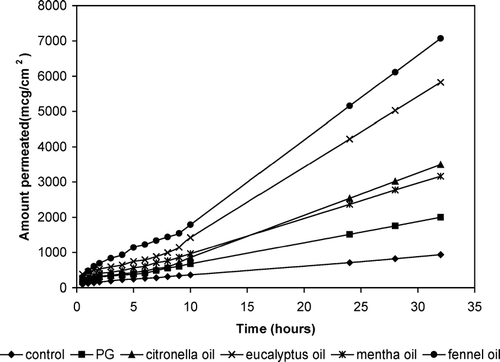
FIG. 2 Permeation profiles of TZN from TDS containing different concentration of eucalyptus oil without pretreatment across mouse epidermis. Each data point represents mean ±SEM (n = 3).
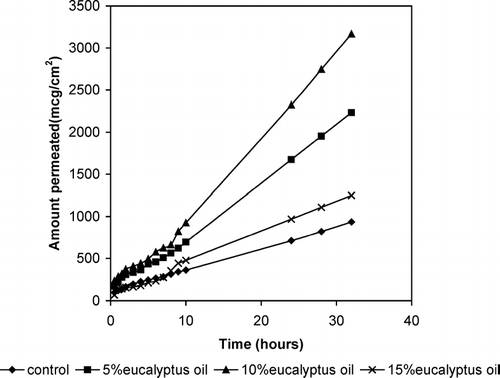
FIG. 3 Permeation profiles of TZN from TDS containing different concentration of fennel oil without pretreatment across mouse epidermis. Each data point represents mean ±SEM (n = 3).
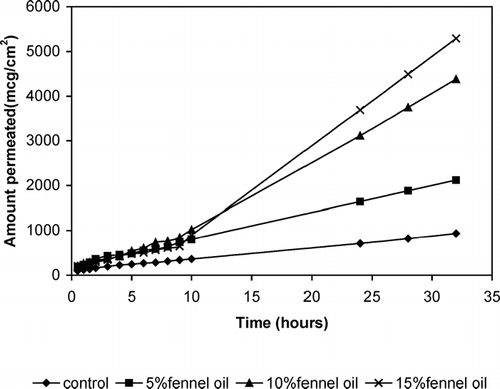
FIG. 4 Permeation profiles of TZN from TDS containing different concentration of mentha oil without pretreatment across mouse epidermis. Each data point represents mean ±SEM (n = 3).

Skin Retention
When the skin was pretreated with 10% essential oils in PG followed by the application of control film, the amount of TZN retentined in mouse skin was similar in all cases and much higher than with no pretreatment and after pretreatment with PG. This indicates that the tissue concentration could be related to the flux values across skin.
When the essential oils were incorporated at the same concentration into the devices, the skin retention of TZN was lower than the values obtained with skin pretreatment and higher than for the control film. These data confirmed that TZN retention was related to flux values across skin. Our result agrees with that of Singh and Roberts (Citation1994), who reported skin concentration after epidermal application of several nonsteroidal anti-inflammatory drugs could be related to their flux values across epidermis.
The amount of TZN retained was almost the same for all essential oils after skin pretreatment with all essential oils followed by subsequent application of devices containing 5% of the same essential oils. These values were similar to those obtained with the control formulation.
CONCLUSION
The permeation of TZN through mouse epidermis is remarkably enhanced by the essential oils. Among the tested essential oils, fennel and eucalyptus oils were the most effective penetration enhancers. Skin pretreatment with essential oils followed by the application of control film or films containing essential oils was found to increase TZN percutaneous absorption and TZN retention in the skin. This protocol can open the way to obtain the systemic absorption of TZN.
However, extensive pharmacodynamic and pharmacokinetic studies are required to establish a correlation before establishing transdermal delivery of TZN using essential oils as penetration enhancers. Because eudragits are biocompatible polymers, we would expect them not to cause any irritant effect to skin even if used for prolonged periods. To evaluate the biocompatibility of the essential oils with the skin, skin irritancy studies are required.
This research work is carried out with financial assistance from University Grants Commission, New Delhi, India.
REFERENCES
- Barry B. W. Lipid-protein-partitioning theory of skin penetration enhancement. J. Control. Rel. 1991; 15: 237–248, [CSA]
- Baker E. J., Hadgraft J. In vitro percutaneous absorption of arildone, a highly lipophilic drug, and the appatrent no effect of the penetration enhancer azone in excised human skin. Pharm. Res. 1995; 12: 993–997, [INFOTRIEVE], [CSA], [CROSSREF]
- Barry B. W., Bennet S. Effect of penetration enhancers on the permeation of mannitol, hydrocortisone and progesterone through human skin. J. Pharm. Pharmacol. 1987; 39: 535–546, [INFOTRIEVE], [CSA]
- Bonina F. P., Carellii V., Cols G. D., et al. Vehicle effects on in vitro skin permeation of a stratum corneum affinity for model drugs caffeine and testosterone. Int. J. Pharm. 1993; 100: 41–47, [CSA], [CROSSREF]
- Cornwell P. A., Barry B. W. Effects of penetration enhancer treatment on the statistical distribution of human skin permeabilities. Int. J. Pharm. 1995; 117: 101–112, [CSA], [CROSSREF]
- Cornwell P. A., Barry B. W. The routes of penetration of ions and 5-fluorouracil across human skin and the mechanisms of action of terpene skin penetration enhancers. Int. J. Pharm. 1993; 94: 189–194, [CSA], [CROSSREF]
- El-Kattan A. F., Asbill C. S., Michniak B. B. The effect of terpene enhancer lipophilicity on the percutaneous permeation of hydrocortisone formulated in HPMC gel systems. Int. J. Pharm. 2000; 198: 179–189, [INFOTRIEVE], [CSA], [CROSSREF]
- Gorecki D. K. J., Verbeck R. K. Trazodone hydrochloride. Analytical Profile of Drug Substances, K. Florey. Academic Press, London 1987; 16: 693–729
- Goodman, Gilman A. Drugs and the treatment of psychiatric disorders. The Pharmacological Basis of Therapeutics, 8th ed. Maxwell Macmillan International, New York 1990; 383–435
- Gao S., Singh J. In vitro percutaneous absorption enhancement of lipophilic drug tamoxifen by terpenes. J. Control. Rel. 1998; 51: 193–199, [CSA], [CROSSREF]
- Goodman M., Barry B. W. Lipid-protein-partitioning (LPP) theory of skin enhancer activity: finite dose technique. Int. J. Pharm. 1989; 57: 29–40, [CSA], [CROSSREF]
- Jain A. K., Thomas N. S., Panchagnula R. Transdermal drug delivery of imipramine hydrochloride: 1. Effect of terpenes. J. Control. Rel. 2002; 79: 93–101, [CSA], [CROSSREF]
- Kaidi Z., Singh J. Mechanism of percutaneous absorption of tamoxifen by terpenes: euginol, D-limonene and menthone. J. Control. Rel. 1998; 55: 253–260, [CSA], [CROSSREF]
- Moghimi H. R., Williams A. C., Barry B. W. A lamellar matrix model for stratum corneum intercellular lipids 11. Effects of geometry of the stratum corneum on permeation of model drugs 5-flurouracil and oestradiol. Int. J. Pharm. 1996a; 131: 117–129, [CSA], [CROSSREF]
- Moghimi H. R., William A. C., Barry B. W. A lamellar matrix model for stratum corneum intercellular lipids 111. Effects of terpene penetration enhancers on the release of 5-fluorouracil and oestradiol from the matrix. Int. J. Pharm. 1996b; 145: 37–47, [CSA], [CROSSREF]
- Moghimi H. R., Williams A. C., Barry B. W. A lamellar matrix model for stratum corneum intercellular lipids 1V. Effects of terpene penetration enhancers on the permeation of 5-fluorouracil and oestradiol through the matrix. Int. J. Pharm. 1996c; 145: 49–59, [CSA], [CROSSREF]
- Monti D., Saettone M. F. Development of a transdermal patch for delivery of propafenone, preliminary studies in vitro. S.T.P. Pharm. Sci. 1997; 7: 235–240, [CSA]
- Monti D., Chetoni P., Burgalassi S., et al. Effects of different terpene-containing essential oils on permeation of estradiol through hairless mouse skin. Int. J. Pharm. 2002; 237: 209–214, [INFOTRIEVE], [CSA], [CROSSREF]
- Martin A., Bustainant P., Chun A. H. C. State of Matter. Waverly B.I., New Delhi 1996
- Narishetty S. T. K., Panchagnula P. Transdermal delivery of zidovudine: effect of terpenes and their mechanism of action. J. Control. Rel. 2004; 95: 367–379, [CSA], [CROSSREF]
- Ogiso T., Iwaki M., Paku T. Effect of various enhancers on transdermal permeation of indomethacin and urea and relationship betweem permeation parameter and enhancement factors. J. Pharm. Sci. 1995; 84: 482–488, [INFOTRIEVE], [CSA]
- Swarbrick J., Bom J. Drug permeation through human skin: 1. Effect of storage condition of skin. J. Invest. Dermatol. 1982; 78: 63–66, [INFOTRIEVE], [CSA], [CROSSREF]
- Singh P., Roberts M. S. Skin permeability and local tissue concentration of nonsteroidal anti-inflamatory drugs after topical application. J. Pharmacol. Exp. Ther. 1994; 268: 144–151, [INFOTRIEVE], [CSA]
- Vaddi H. K., Ho P. C., Chan S. Y. Terpenes in propylene glycol as skin penetration enhancers: permeation and partition of haloperidol, fourier transform infrared spectroscopy, and differential scanning calorimetry. J. Pharm. Sci. 2002; 91: 1639–1651, [INFOTRIEVE], [CSA], [CROSSREF]
- Yamane M. A., Williams A. C., Barry B. W. Terpene penetration enhancers in propylene glycol/water co-solvent systems: effectiveness and mechanism of action. J. Pharm. Pharmacol. 1995; 47: 978–989, [INFOTRIEVE], [CSA]
- Zhao K., Singh J. Mechanism(s) of in vitro percutaneous absorption enhancement of tamoxifen by enhancers. J. Pharm. Sci. 2000; 89: 771–780, [INFOTRIEVE], [CSA], [CROSSREF]

